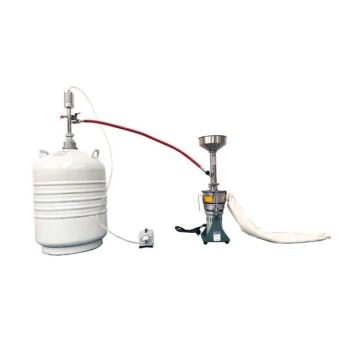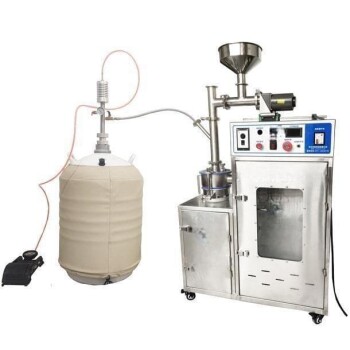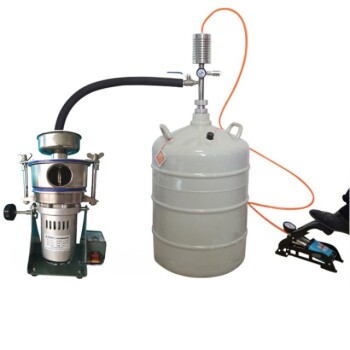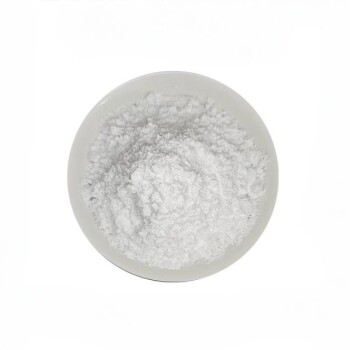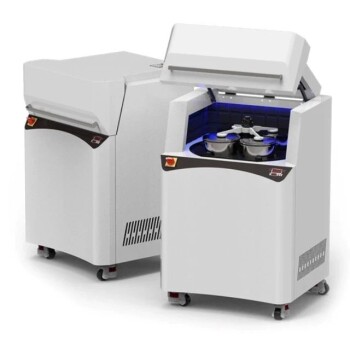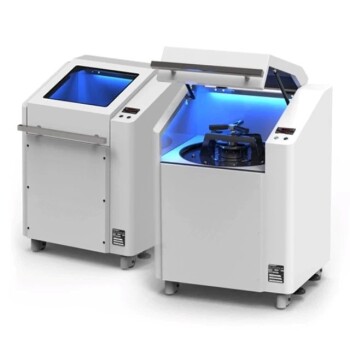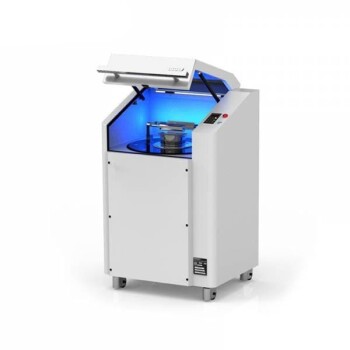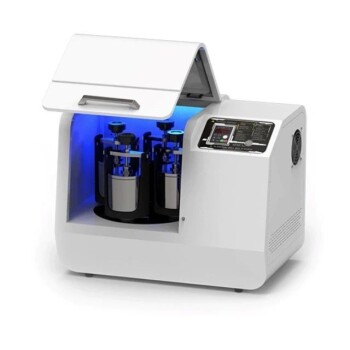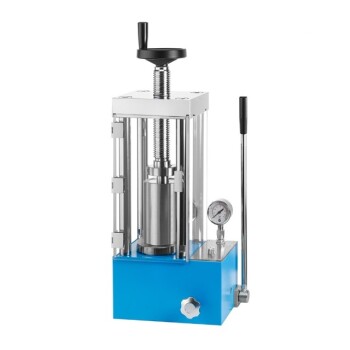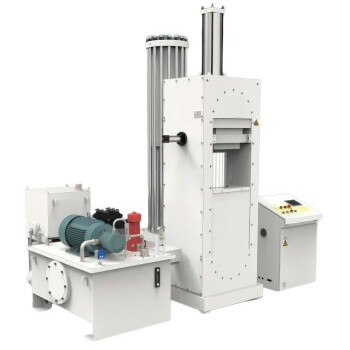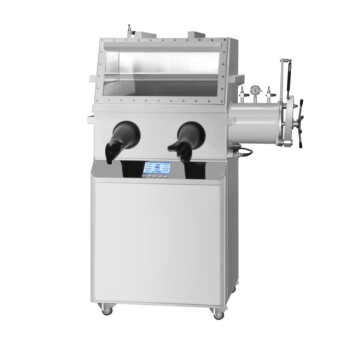粉碎简介
粉碎的目的和方法
粉碎是材料科学和工业应用中的一个关键过程,主要目的是减小材料的粒度,使其分布更加均匀。这一过程对于分析、混合和进一步加工等各种后续操作至关重要。破碎所采用的方法多种多样,并根据所加工材料的具体特性而量身定制。
主要的破碎方法包括
- 挤压:这种方法是在两个表面之间对材料施加压力,逐渐缩小其尺寸。常用于 实验室颚式破碎机 和辊式破碎机。
- 冲击:物料受到突然的高能量冲击,通常在 实验室锤式粉碎机 或冲击式破碎机,将其破碎成更小的碎片。
- 剪切:也称为切割,这种方法是使用刀片或锋利的边缘将材料切成更小的碎片。切割粉碎机就是使用这种技术的典型设备。
- 摩擦:这种方法依靠材料之间或材料与表面之间的摩擦作用,逐渐磨损颗粒。这种方法常用于研磨机。
不同的物料需要特定的破碎设备才能达到最佳效果。例如,矿物和陶瓷等硬脆材料通常使用 实验室颚式破碎机 或圆锥破碎机进行处理,它们会施加高压。相比之下,木材和橡胶等较软、纤维较多的材料使用切割机或 实验室锤式粉碎机 使用剪切力和冲击力。
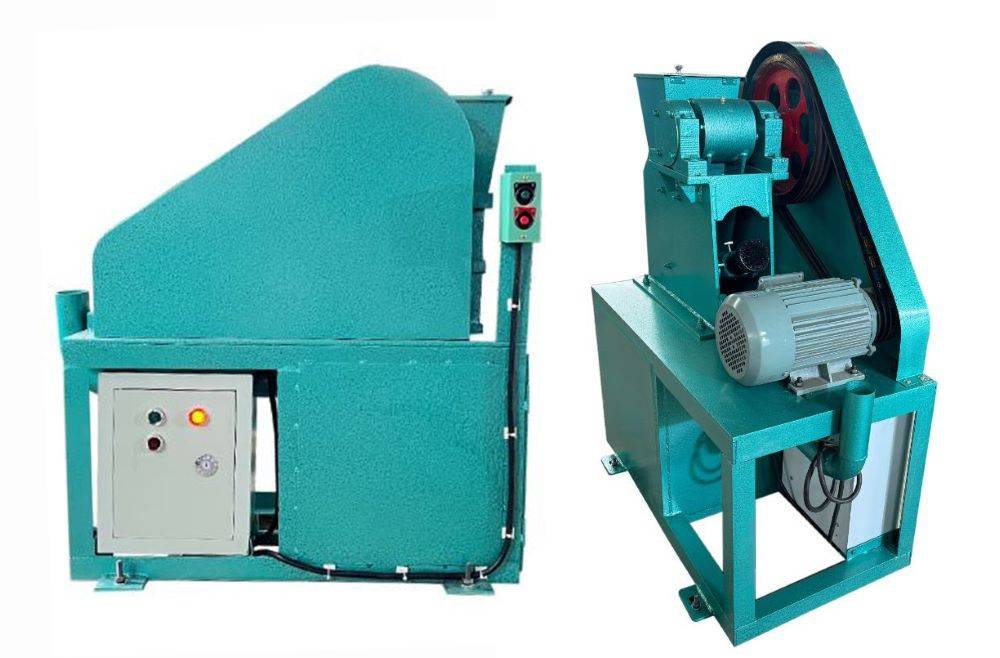
设备和方法的选择对于确保粉碎过程的效率和效果至关重要,并最终影响最终产品的质量和一致性。
粉碎过程中的挑战
虽然机械力通常足以减小许多材料的尺寸,但在实现最小颗粒尺寸时,机械力可能会有所不足。挤压、冲击、剪切、切割和摩擦等传统方法可以均匀样品并减小其尺寸,但在处理某些类型的材料时往往会遇到限制。例如,太硬、太有弹性或对热太敏感的材料会带来巨大挑战。
在这种情况下,传统的机械粉碎技术可能无法奏效。在室温下呈现塑性变形的材料尤其如此,因为它们往往会变得粘稠,不易破碎。此外,含有挥发性成分的材料或在常温下受机械应力作用而降解的材料也会出现问题。因此,需要采用其他方法来达到所需的粒度并保持材料的完整性。
低温粉碎是应对这些挑战的可行解决方案。通过使用液氮或其他低温流体将材料冷却到极低的温度,材料的性质会发生变化,使其变得更脆,更容易研磨。这种方法不仅克服了机械力的限制,还能确保材料的结构和化学成分在粉碎过程中保持不变。
低温粉碎过程
详细工作流程
低温粉碎过程首先使用低温氮气对材料进行预冷。这一步骤至关重要,因为它能显著降低材料的温度,通常达到零度以下。预冷阶段可确保材料变脆,使其更容易粉碎。
材料充分冷却后,就会进入高速旋转锤式粉碎机。这些碾磨机以极高的速度运转,利用预冷材料的脆性将其有效地碾磨成细粉。锤式粉碎机的高速旋转会产生巨大的冲击力,有助于将材料粉碎成更小的颗粒。
粉碎阶段结束后,得到的粉末还要经过一个关键步骤,即气固分离。这一过程包括将细粉从冷却和破碎阶段使用的氮气中分离出来。气固分离通常通过使用过滤器或旋风分离器来实现,它们可以捕捉粉末,同时允许氮气循环使用或安全释放。
最后,对分离出来的粉末进行进一步加工,以满足特定要求。这可能包括额外的精炼步骤,以确保均匀性和一致性,也可能包括对粉末进行包装,以用于各种应用。整个工作流程旨在最大限度地提高粉碎过程的效率,同时保持最终产品的完整性和质量。
优缺点
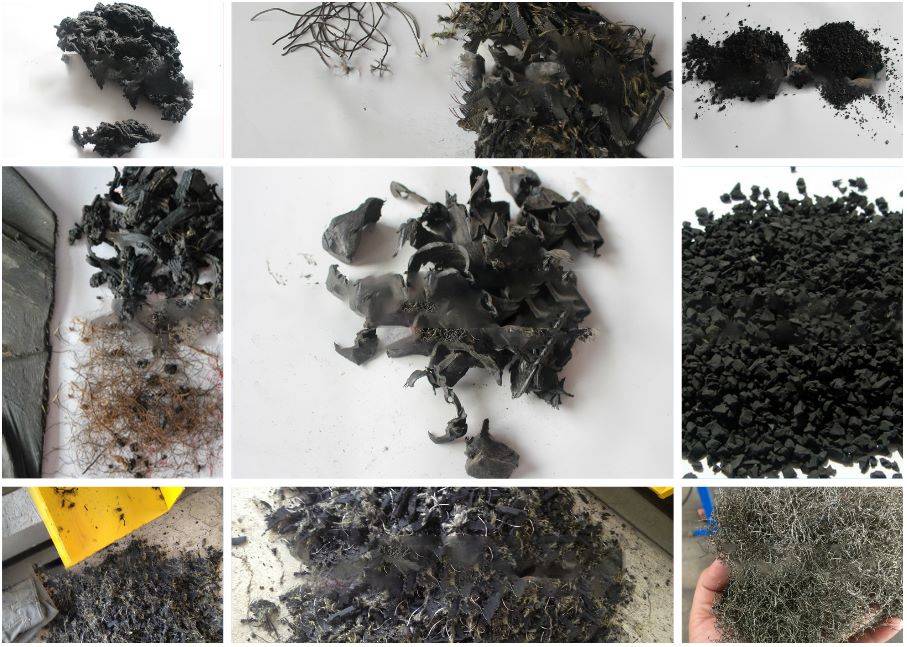
低温粉碎的优点
低温粉碎具有一系列优点,使其成为粉碎常温下难以加工的材料的一种优越方法。主要优点之一是能够粉碎在低温下表现出脆性的材料,而这种特性在常温条件下通常是不存在的。这种能力对于橡胶、塑料和金属的高质量回收利用尤为重要,因为传统方法可能无法达到所需的粒度和均匀性。
该工艺还能很好地保持敏感材料的完整性,如食品和药材中的营养成分。通过在低温条件下运行,热降解降到了最低程度,确保了这些材料的营养价值和基本特性得以保持。这对于食品和制药等产品质量和一致性要求极高的行业至关重要。
| 优点 | 说明 |
|---|---|
| 提高生产率 | 优化粒度和提高产量可提高生产率和降低能耗。 |
| 提高安全性 | 低温条件下形成的惰性环境降低了氧化和火灾风险,从而提高了操作安全性。 |
| 均匀的颗粒分布 | 低温研磨产生的超细颗粒分布范围窄,可确保稳定性并提高产品性能。 |
| 减少设备磨损 | 低温环境可减少研磨设备的磨损,从而降低维护成本,延长设备使用寿命。 |
| 消除结块 | 低温碾磨可防止产品在碾磨机内结块,从而确保平稳、连续的运行。 |
总之,低温粉碎不仅扩大了可有效加工的材料范围,还提高了最终产品的质量和安全性,使其成为各种工业应用中不可或缺的技术。
低温粉碎的缺点
虽然低温粉碎技术具有多种优势,例如可以加工在室温下难以粉碎的材料,但它也并非没有挑战。主要缺点之一是使用液氮(LN2)的运营成本较高,而液氮对于维持工艺所需的低温至关重要。LN2 的费用加上需要专门设计用于在这种极端温度下运行的设备,大大增加了低温粉碎的初始成本和持续成本。
此外,用于低温粉碎的设备必须使用能够承受低温操作的材料。与传统研磨方法相比,这往往需要更复杂的密封机制,从而进一步增加了设备的复杂性和成本。塑料等材料所需的特殊粉碎工作大大高于矿物粉碎,这也增加了总成本。
总之,虽然低温粉碎技术具有独特的优势,但其高昂的运营成本和对专业、昂贵设备的需求仍然是其明显的缺点,在评估其在特定应用中的可行性时必须仔细考虑。
低温粉碎的应用
生物样品
低温粉碎在保存生物样本方面起着至关重要的作用,尤其是在食品、医药和生物技术领域。通过利用低温,该技术可有效防止敏感生物分子变性,确保样品的完整性和活力。这在从组织中提取 DNA 等应用中尤为重要,因为保持核酸的结构和功能特性对于准确分析至关重要。
在中草药领域,低温粉碎技术可在不影响中草药有效成分的情况下将中草药磨细。这种方法不仅能提高草药粉末的均匀性,还能保留其治疗特性,否则传统的研磨技术可能会失去这些特性。在此过程中使用液氮会使植物材料脆化,使其更容易受到机械粉碎的影响,同时将热引起的降解降至最低。
此外,低温粉碎在需要处理精细生物材料的生物技术流程中也非常重要。例如,它有助于制备细胞裂解物和蛋白质样品,在这种情况下,保存原生结构对于质谱分析和电泳等下游应用至关重要。在低温条件下保持样品完整性的能力是一大优势,可使研究人员获得可靠、可重复的结果。
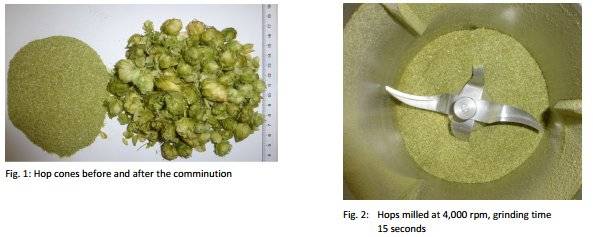
总之,在生物样品中应用低温粉碎技术不仅仅是为了减小颗粒大小,而是为了保存所处理材料的本质。这项技术可确保这些样本中的有价值成分保持完整,以便在各种科学和工业环境中进行进一步分析和利用。
弹性和聚合物材料
低温粉碎在回收废塑料和废橡胶方面尤为有效。在低温条件下,这些材料会脆化,大大降低其韧性,使其更容易研磨成细小颗粒。这一工艺不仅有利于这些材料的回收利用,还能提高回收产品的质量。
弹性和聚合物材料在低温下的脆化是这项技术的一个关键方面。当暴露在低温下时,这些材料的分子链会变得不那么灵活,从而形成更脆的结构。材料特性的这种变化使得研磨效率更高,因为材料可以用更少的能量和精力分解成更小的颗粒。
此外,在回收利用过程中使用低温粉碎法还能确保材料的完整性。与可能导致材料性能退化或丧失的传统方法不同,低温粉碎可保持回收产品的结构和化学完整性。这对于回收材料质量至关重要的应用领域尤为重要,例如生产高性能塑料或橡胶复合物。
总之,低温粉碎通过在低温下脆化弹性材料和聚合物材料,为回收利用提供了一种优越的方法,从而提高了粉碎过程的效率,并保持了回收产品的质量。
挥发性成分样品
低温粉碎对处理苯和多氯联苯 (PCB) 等易挥发性材料尤为有效。该工艺利用低温防止挥发性化合物逸出,从而保持样品的完整性和纯度。
在室温下采用传统的粉碎方法时,这些挥发性成分很容易挥发,导致大量损失,影响分析结果。相比之下,低温粉碎可确保样品在整个粉碎过程中保持完好无损。通常使用液氮实现的超低温可固定挥发性化合物,防止其逸出,确保最终粉末保持原始化学成分。
在环境监测、化学分析和质量控制等对挥发性化合物的保存至关重要的行业中,这种方法是不可或缺的。在不损失挥发性成分的情况下保持样品完整性的能力大大提高了后续分析程序的准确性和可靠性。
金属材料
低温粉碎在回收电子废弃物(电子垃圾)以回收铜、锌和铝等有价值的有色金属方面发挥着关键作用。该工艺包括用低温氮气对电子废料进行预冷,使金属脆化,从而使其更易粉碎。随后的高速旋转锤式研磨进一步将这些脆化的材料分解成细粉,从而促进有色金属的有效分离和回收。
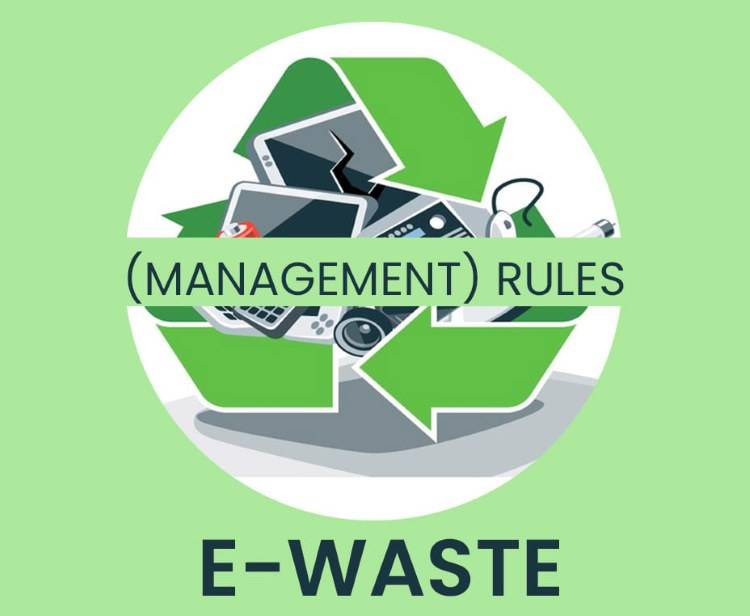
在这种情况下应用低温粉碎技术有几个优点。首先,它可以处理在室温下难以粉碎的材料,从而提高回收过程的整体效率。其次,由于低温可防止金属在粉碎过程中发生热降解或氧化,因此可确保材料的完整性。
| 金属 | 典型应用 | 回收挑战 |
|---|---|---|
| 铜 | 布线、电路板 | 高导电性,与其他金属混合 |
| 锌 | 电池、压铸件 | 高温易挥发,形成氧化物 |
| 铝 | 外壳、结构部件 | 高反应性,混合合金 |
上表强调了这些金属在电子设备中的典型应用,以及它们在回收过程中面临的具体挑战。通过低温粉碎来解决这些难题,可以显著提高这些有价金属的回收率,从而有助于实现更可持续、更经济可行的电子废物管理方法。
预防措施和最佳实践
设备和材料
在实施低温粉碎时,设备和材料的选择对于确保工艺的有效性和安全性至关重要。研磨罐通常由 不锈钢 或 聚四氟乙烯(PTFE) 磨罐通常由不锈钢或聚四氟乙烯(PTFE)制成,其耐腐蚀性和耐低温能力是选择的标准。不锈钢罐具有耐久性和强度,而聚四氟乙烯罐则具有出色的耐化学性,是处理敏感或反应性材料的理想选择。
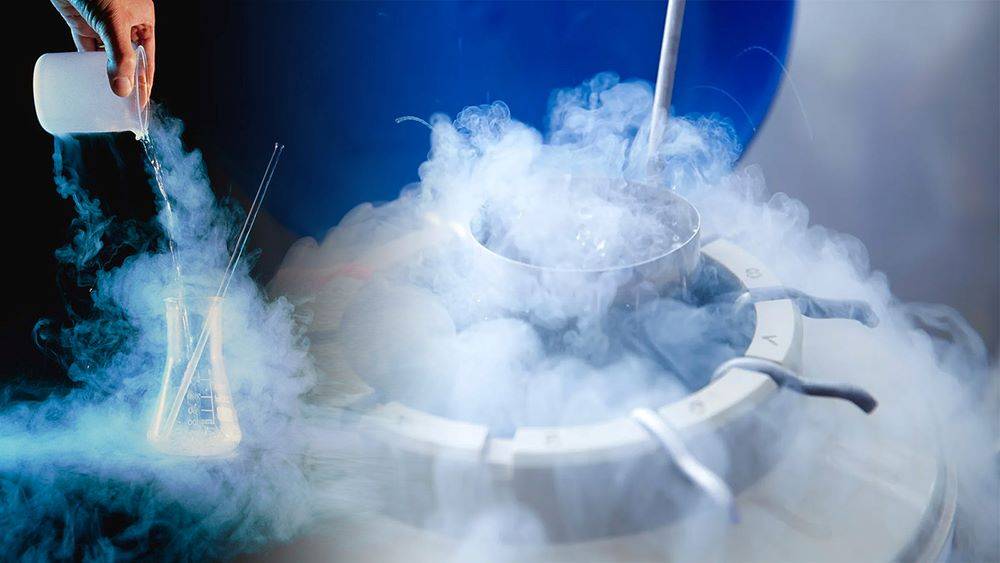
研磨助剂的选择,如 液氮 或 干冰 在很大程度上取决于所处理样品的类型和数量。液氮的沸点极低(-196°C),通常因其快速冷却能力而受到青睐,可有效脆化室温下难以粉碎的材料。干冰的沸点为-78.5°C,是一种更经济的选择,适用于不需要液氮提供的超低温的样品。
| 研磨助剂 | 温度 | 适用性 |
|---|---|---|
| 液氮 | -196°C | 非常适合需要快速深度冷却的材料,如橡胶和塑料废料。 |
| 干冰 | -78.5°C | 适用于对温度不太敏感的材料,是一种经济高效的替代方案。 |
通过仔细考虑样品的特性和研磨助剂的能力,操作人员可以优化低温粉碎过程,确保效率和安全。

